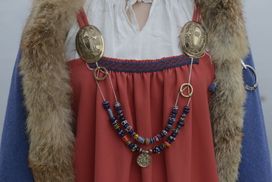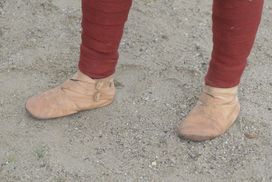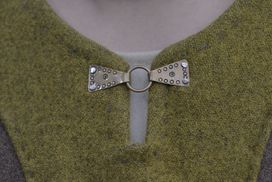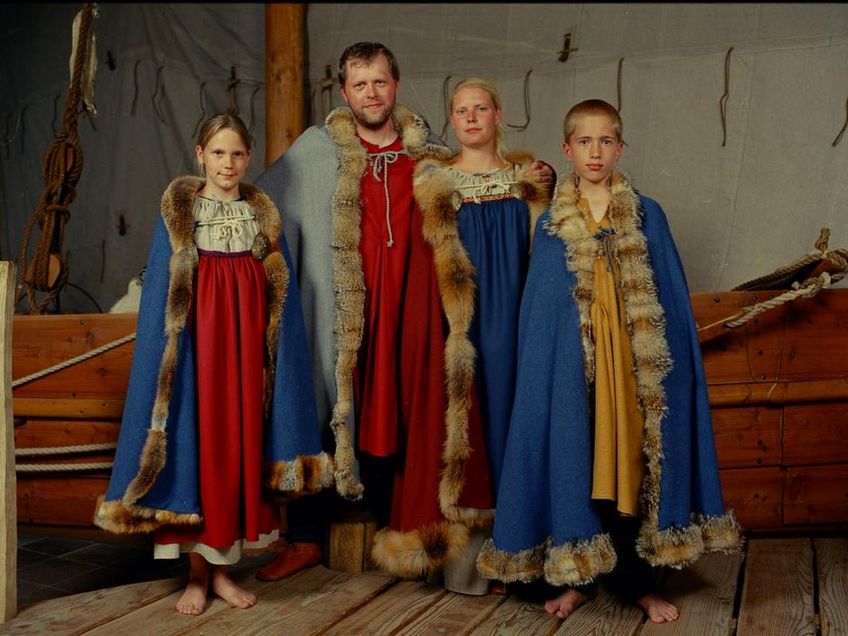
Viking Age People
Findings of skeletons and artefacts contains many information about the Viking as people.
Preserved skeletons show that that the Vikings were, on average, 8-10 cm shorter than we are today and they rarely achieved an age of more than 40-50 years. Arthritis was common and many had worn or missing teeth. Cavities in the teeth were, on the other hand, uncommon, as they did not eat much sugar. Only few skeletons show evidence of violence.
There are a few finds from Viking times which provide such a detailed image of people that it is possible to say something about the Vikings' hair and clothes. These are finds of small bronze and silver figures and tapestries which depict women with beautifully arranged hair and long dresses. The men are also shown with neat hairstyles and often with a moustache and, in some instances, a full beard.
Viking clothes
Unfortunately, almost all the information we have concerns the clothes of the rich, because there were generally better conditions for preservation in rich people's graves and they could afford grave goods.
Their clothes would comprise dresses, coats, trousers and capes of wool and linen, sometimes decorated with bands and borders of, for example, furs. Shoes and boots, together with "rainwear", were made of leather. The rich Vikings dyed their clothes in bright colours.
Both men and women adorned themselves with jewellery: Brooches, armbands, necklaces and neck rings are especially characteristic of Scandinavia, but imported glass was also used to make bead necklaces and some brooches show the influence of foreign traditions. This is true for example of the ring brooches which men, in particular, wore at their right shoulder to fasten their capes. These pieces were inspired by Irish brooches, and were made by Vikings in Norway and the British Isles.
The Viking man's clothes
The men wore a tunic, trousers and robe. A tunic is reminiscent of a long-sleeved shirt that goes right down to your knees. Over the shoulder, they wore a robe, which was closed with a buckle. On their feet, they wore leather shoes or boots.
In winter, they wore a cap made of fabric or fur.
The Viking woman's clothes
The women wore a dress that was held up by two short straps at the front and two longer onea at the back of the dress. The straps were assembled at the front with large bowl buckles that were secured with a needle on the back. Between the bowl buckles, the women could wear beautiful necklaces with amber, silver, bone or glass beads of different colors.
On her feet she wore leather shoes.
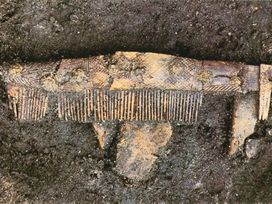
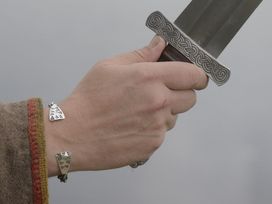
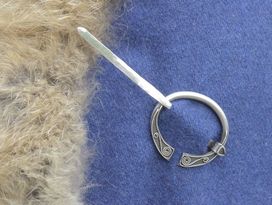
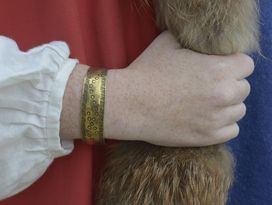
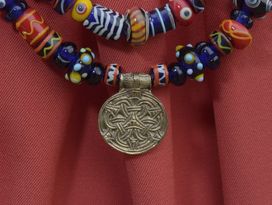
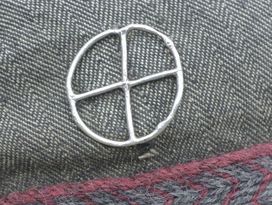
Adornment
The Vikings must have taken great care of their hair as one of the most common finds from the Viking Age are combs made of wood or bone. Both men and women adorned themselves with jewellery: Brooches, armbands, necklaces and neck rings are especially characteristic of Scandinavia, but imported glass was also used to make bead necklaces and some brooches show the influence of foreign traditions.
Many of the ring buckles that men in particular wore on the right shoulder to hold their capes together are inspired by Irish buckles and designed by Vikings in Norway and the British Isles.
Antlers and bone were used for knife shafts, combs, playing pieces, hair clips, belt buckles, decorations on boxes and spoons.
Skates were made from horse bones.
Whale bones were used to make clamps, and jewelery pendants were made from walrus teeth.
On the men's belt there was, as a rule, a knife and a leather pouch containing various personal items such as a fire steel, comb, gaming pieces, silver coins and much more.
The Vikings also adorned themselves with amulets and pendants shaped as Thor's hammer made from antlers and wood.
Finger rings were made of amber, fossil coal, copper alloys, silver and gold.
Historical characters
In the late Viking Age when the war ship Skuldelev 2 (reconstruction: The Sea Stallion) sailed from Dublin to Roskilde several danish as well as foreign kings sought to gain control over England.Â
They are listed below and in the menu to the right according to year og birth.
Exercises
Kings
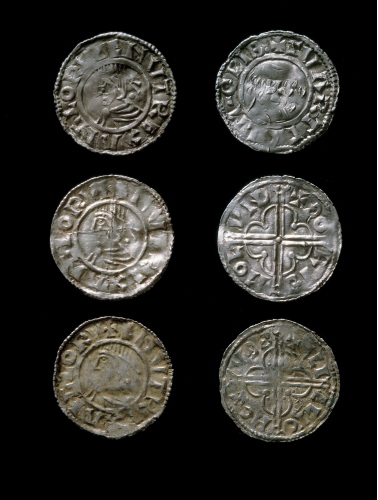
- King of Denmark (AD 1018-1035), England (AD 1016-1035) and Norway (AD 1028-1030).
Cnut (c. AD 996-1035) was the son of King Svein Forkbeard (AD 960-1014) and took part at an early age in his father’s Viking expeditions to England. After Svein’s death in AD 1014, Cnut remained in England as leader of the Danish army. Two years later, on the death of the English king Ethelred, he became sole King of England.
Meanwhile, his brother was King Harold II of Denmark, but when he died in AD 1018, Cnut was also crowned king of Denmark. He succeeded in retaining power in both countries and for a time also controlled parts of Norway and Sweden. On his death in AD 1035 the Danish throne went to his son Hardicanute and the English to another son, Harold Harefoot, who ruled England until AD 1040.
Cnut and his sister, Estrid, were in many ways the link in the relationship between the four main characters in the Battle of England: Edward the Confessor, Harold Godwinson, William the Conqueror and Svein Estridsson.
Birth: 996
Dead: 1035
Buried: Winchester Cathedral
King: Denmark 1018 - 1035, England 1016 - 1035, Norway 1028 - 1030
Parents: Svein Forkbeard and Gunhild
Spouse: Emma of Normandy
Children: Svein Alfivasen (with Ælgifu), Harald Harefod (with Ælgifu), Hardeknut (with Emma), Gunhild (with Emma)
- King of England AD 1042-1066.
Edward (c. AD 1003–1066), son of the Norman Emma and the Anglo-Saxon king Ethelred was sent to Normandy at a young age, after the Danish King Canute the Great (c. AD 996-1035) overtook his father's throne and married his mother. After almost 30 years in exile, Edward returned to England where, in AD 1042, he was crowned king. Edward was married to Edith from the powerful Godwin family but they had no children and the English throne passed to Edith's brother Harold Godwinson when Edward died in AD 1066.
But the transfer of the English throne to Harold Godwinson gave problems. Edward's many years in France had a great influence on his rule and he was known for speaking more French than English, for surrounding himself with French advisors and for using Norman troops in England. This was perhaps the reason that William the Conqueror, on Edward's death in AD 1066, maintained that he had been promised the English throne by Edward.
Birth: 1003
Death: 1066
Buried: Westminster Abbey
King: 1040 - 1066
Parents: Ethelred the Unready and Emma
Spouse: Edith of Godwin
- King of Norway 1046-1066
Harald Hardrada (Harald III Sigurdsson) is often known as "the last real Viking," and maybe he was what many understood by a real Viking king. He was born in 1015, son to the chieftain Sigurd Syr, and with war in the blood from when he as a 15-year old participatede in the Battle of Stiklestad till he died during the Norwegian invasion of England in 1066.
Harald distinguished himself in the Battle of Stiklestad, a battle between the Danish king Cnut the Great and Haralds half-brother, the later Norwegian king-saint Olav II Haraldsson (Saint Olaf). Being on the losing side, however, Harald had to flee. First he went to Kiev, where he found protection with Prince Jaroslav, a descendant of some of the Vikings who settled there. Then Harald moved on to Constantinople, where he fought in the so-called Varangian Guard. This was an elite unit in the Byzantine army, consisting of Vikings, Englishmen and Normans. As a commander in the Byzantine army, Harald fought in places as far apart as the Mediterranean, Asia Minor, Sicily, the Holy Land and in Constantinople proper.
Rich in combat experience and wealth he returned to Scandinavia n 1046 where he was quick to play his part in the local entanglements. Here, the Norwegian-Danish king Magnus the Good (Magnus I of Norway) fought the Danish pretender Svein Estridsson. Initially, Harald and Svein joined forces, but when Magnus offered Harald co-kingship, he betrayed Svein.
Shortly afterwards, in 1047, Magnus died. Possibly from the injuries he received when pursuing Svein after a battle on Zealand, where he according to legend fell of his horse. Magnus willed Harald to have Norway and Svein Denmark.
Harald was not content with this, however, and in the following years he and Svein often crossed swords - both on land and at sea. Harald plundered and burned Haithabu in 1049 for example, as well as plundering and ravaging many other Danish places during the years. The Skuldelev-blockade of Roskilde Fjord, whose first phase is dated to about 1060, is often interpreted as an attempt to secure Roskilde from Haralds surprise attacks after the disaster in Haithabu. Even though much of Haralds ravaging of Denmark seems pointless today, he probably was too much of a strategist to take on casual raids. Maybe his purpose was to show the Danes how Svein was unable to protect his coasts, thereby depriving him of the Danes' support.
Despite the fact that Svein Estridsson lost almost every battle against Harald, he held on to power. In 1062, or shortly afterwards, a compromise was reached. The warrior king Harald must have realized, that he should seek out new hunting grounds, and following the death of Edward the Confessor in the beginning of 1066, Harald invaded England. At fall the same year he fell in the Battle of Stamford Bridge against England's new king, Harold Godwinson.
Kristian Helmersen
Literature
DeVries: The Norwegian invasion of England in 1066. 2003
In Danish
Johannessen: Politikens bog om Danmarks vikingetid. 2001
- King of Denmark AD 1047-74.
Svein (AD 1020-1074) was the son of Cnut the Great's sister Estrid and her Norwegian husband, Ulf Jarl (Earl Ulf). When the Norwegian king Magnus ascended the Danish throne in AD 1042, Svein was made an earl – just as his father had been under Cnut the Great. In AD 1043, Svein took part in the Battle at Lyrskov Hede, where a great Wendic invasion army was driven back. Svein won a great reputation in the battle and the Danish army elected him as king at Viborg Thing.
This event brought Svein into conflict with Magnus and there were several battles for the Danish throne. In AD 1047 there was a great battle on Zealand where Svein was defeated and was forced to flee. Magnus set off in pursuit but during the chase he was thrown from his horse and died subsequently of his injuries. On his deathbed, he gave over the Norwegian throne to his uncle Harald Hardrada and the Danish throne to Svein.
As Danish king, Svein was on several occasions challenged by Harald Hardrada but they became reconciled in AD 1062 and recognised each other as kings of Denmark and Norway, respectively.
When the English King Edward the Confessor died in AD 1066, Svein saw himself as a possible successor to the English throne, which was, however, overtaken by Harold Godwinson, who quickly lost it to William the Conqueror, duke of Normandy, in the Battle of Hastings. When Harold Godwinson's children subsequently travelled to Roskilde to look for help from Svein, who was their farther's cousin, he chose in AD 1069 to support his brother Asbjörn's expedition to Northern England.
Asbjörn went with two of Svein's sons to the Dane-friendly town of York in order to find support in raising an army against William. In order to frighten the inhabitants into not supporting Asbjörn in a revolt, William had in the meantime burnt fields and houses in the area. The Danes were forced to abandon the expedition and their opportunity to conquer the English throne. Svein Estridsson died in AD 1074 and was buried in Roskilde Cathedral.
Louise Kæmpe Henriksen
- King of England AD 1066-1066.
Harold (c. AD 1022–1066) was son of Earl Godwin who, from the beginning of the 11th century, was one of the most prominent men in England.
Earl Godwin was married to Gyda, the sister of Earl Ulf, Canute the Great's brother-in law and his deputy in Denmark. Godwin had been Canute's most trusted man in England but after Canute's death and the crowning of Edward the Confessor the family were driven from the country and were forced to seek refuge in Dublin. When Edward allowed the family to move back to England in AD 1052 Godwin re-won the king's confidence and was given back his earldom in Wessex.
When Earl Godwin died he left the whole of his earldom to his son Harold, and as the new head of the family Harold became one of England's most powerful men. The earl's daughter Edith married King Edward.
In AD 1065, Harold supported Edward in his fight against rebels from Northumbria. The rebels were led by Harold's own brother Tostig, who was earl in that area, and the battles ended with Harold encouraging the king to banish Tostig from the country.
King Edward, who had been ill for some considerable time, died in January AD 1066, and Harold who, in practice, had already ruled the country maintained that Edward had promised him the throne on his deathbed. The very day after Edward's death he was crowned Harold II, king of England.
Louise Kæmpe Henriksen
William (c. AD 1027-1087) was the son of Robert I of Normandy and great-great-great-grandson of the Viking chieftain Rollo who, by way of an attack on France in AD 911, and subsequent peace negotiations, became Duke of Northern France.
After innumerable power struggles between the French Counties, William himself became Duke of Normandy in AD 1046.
The Anglo-Saxon Chronicle mentions, in a very few lines, that William visited Edward the Confessor in England in AD 1051:
Earl William came from beyond the sea with a great company of Frenchmen and the King received him and as many of his companions as he thought appropriate and then he let him depart again.
It must have been during this visit that Edward, as William later maintained, promised him the English throne. As the latter was given instead to Harold Godwinson on Edward's death in AD 1066, William declared war on the new king. The Bayeux Tapestry shows how William arrived in Southern England on 28th September with a great fleet and almost 7000 men. On 14th October the Norman army met the English troops at the Battle of Hastings, where Harold Godwinson was killed and William began his conquest of England.
In the subsequent months, William plundered and burned a number of towns in Southern England and took over control. For this reason he was given the byname “the Conqueror”. On Christmas Day of that same year, William was crowned king in Westminster Abbey in London. He remained on the throne until his death in AD 1087.
William's half-brother Odo was the bishop in Bayeux. The church here was consecrated in AD 1077 and several sources are of the opinion that the Bayeux Tapestry, which describes the Battle of Hastings and William’s conquest of England, was made specifically for the building.
Louise Kæmpe Henriksen
Other historic people
Ansgar (c. AD 800-865) was a missionary for the archiepiscopal see in Hamburg-Bremen, which had the Nordic Countries as its mission area.
There were probably quite a number of German/Frankish missionaries in the Nordic Countries, but Ansgar is one of the few we know of, in particular because a biography was written of him. There was a wish to have him declared a saint after his death, so it was necessary to ensure that his life history was written down, together with all his deeds and achievements. Consequently, we must be rather cautious in believing everything that was written down; perhaps there was some exaggeration in order to make it easier to have him beatified.
Ansgar's missionary work was among the Saxons, Danes and Swedes. In addition to the fact that the monks, of course, wished to convert as many people as possible to Christianity, conversion of the Nordic peoples was also important for the Frankish Emperor. Perhaps these warlike neighbours would give fewer problems if they became Christians.
Ansgar's first missionary expedition was in AD 826, during which he spread the Christian message among the Saxons and possibly also the Danes of Southern Jutland. But shortly afterwards, in c. AD 830, he travelled to Sweden, where he established himself in particular in Birka. According to Angar's Life History, he converted many people here and obtained permission to build a church. This is the earliest church in the Nordic Countries.
Back in Hamburg, a couple of years later he was appointed as Archbishop of Hamburg diocese, which also had the Nordic Countries within its area of responsibility. Subsequently, he functioned in particular as a diplomat rather than an actual missionary, acting between the Danish King and the Frankish King/Emperor. He was given permission to build churches in both Haithabu and Ribe.
On Ansgar's death, in his sick bed in AD 865, Christianity had not become particularly well established in the Nordic Countries. It was first with the arrival of Harald Bluetooth that Christianity really took hold.
So when Ansgar is referred to as the "Nordic Apostle" this is probably somewhat of an exaggeration.
Kristian Helmersen
Adam of Bremen (c. AD 1040-1081) was a German monk attached to the Cathedral in Bremen – hence his name. He was responsible for writing the work The History of the Archbishops of Hamburg, but apart from that we know very little about him.
The History of the Archbishops of Hamburg dates from around AD 1070 and was originally written in Latin:Gesta Hammaburgensis Ecclesiae Pontificum. Adam himself referred to it as: Historia Hammaburgensis Ecclesiae. It is one of the most important sources concerning the geographic, political and ecclesiastical situations in Northern Germany, Denmark and the other Nordic Countries in the period around AD 870-1070. Despite the title, it deals with much more than the history of the Hamburg-Bremen Archiepiscopal See. This is due to the fact that the Archiepiscopal See had been given the responsibility for spreading the Christian faith in the Nordic Countries by the Pope. As a consequence, there was great interest in all aspects of this area.
It is uncertain whether Adam ever travelled around in Denmark. He writes that he used the Danish King Svein Estridsson as a source. But he may merely have spoken with Svein during the King's travels in Southern Jutland. In addition to Svein, who supplied Adam with a great amount of information, he probably also spoke with sailors, travellers and merchants.
The work contains a great deal of information: descriptions of trade routes, reports of wars, of Christians and heathens and much more. But there are also some things that seem rather strange. For example, he writes that the Nordic countries are the home of Amazons and monsters such as – humans with dog heads. He is unlikely to have heard people foretell that they have seen these beings in the Nordic Countries. However, he could have read about them and where they were said to live in some much older texts – some as ancient as from 200 BC.
Kristian Helmersen
Literature
Adam of Bremen: History of the Archbishops of Hamburg-Bremen.English translation by F.J. Tschan. 2002.
853 - ca. 871 Olaf
863 - 867 Auisle
ca. 871 - 873 Ivar I
873 - 875 Eystein Olafsson
877 - 881 Bardr
883 - 888 Sigfred
888 - 893 Sihtric I (afsat)
893 - 894 Sigfred jarl
894 - 896 Sihtric I (genindsat)
896 - 902 Ivar II (fordrevet)
917 - 921 Sihtric Cáech (konge af York 921 - 927)
921 - 934 Guthfrith (konge af York 927)
934 - 941 Olaf Guthfrithsson (konge af York 939 - 941)
941 - 945 Blacaire
945 - 980 Olaf Sihtricsson (abdiceret; konge af York 941 - 944, 949 - 952)
980 - 989 Járnkné Olafsson
989 - 1036 Sihtric Silkeskæg (abdiceret)
1036 - 1038 Echmarcach mac Ragnaill (afsat)
1038 - 1046 Ivar Haraldsson (afsat)
1046 - 1052 Echmarcach mac Ragnaill (genindsat, afsat; konge af Man 1052 - 1064)
1052 - 1070 Murchad mac Diarmata
1070 - 1072 Domnall mac Murchada eller Diarmit mac Máel
1072 - 1074 Gofraid (afsat)
1074 - 1086 Muirchertach ua Briain
1086 - 1089 Enna eller Donnchad
1091 - 1094 Godred Crovan (fordrevet; konge af Man 1079 - 1095)
1094 - 1118 Domnall mac Muirchertaig ua Briain (afsat; konge af Man 1096 - 1098
Kursiv = konger af ikke-nordisk oprindelse.
